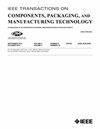Compact Waveguide Filtering Power Dividers With Flexible Division Ratio and Enhanced Selectivity
IF 2.3
3区 工程技术
Q2 ENGINEERING, ELECTRICAL & ELECTRONIC
IEEE Transactions on Components, Packaging and Manufacturing Technology
Pub Date : 2024-10-21
DOI:10.1109/TCPMT.2024.3483773
引用次数: 0
Abstract
This article proposes a novel design approach for multiport waveguide (WG) filtering power dividers (FPDs) with compact size and enhanced selectivity. A modified cascade trisection (CT) as a basic building block is first investigated allowing for more transmission zeros (TZs) with reduced resonators. Then, the implementation method is given and a bandpass filter (BPF) is designed, where the three poles within the passband are contributed by two rectangular WG (RWG) resonators and a half-wavelength coupling slot connecting them. The coupling slot not only acts as a resonant node but also easily provides intercavity cross-coupling. Besides, the stacked configuration combined with the input/output coaxial feeding scheme enables the enhancement of selectivity by the anticipated two TZs above the passband. An instructive design method for FPDs is proposed, in which the different power divisions mainly depend on the electric field distribution of the fundamental mode of the RWG. Finally, two three-way equal/unequal FPDs with the power division ratios of 1:1:1 and 1:2:1 are simulated, fabricated, and measured. Compared to the reported FPDs, the proposed work demonstrates good features, such as low insertion loss (IL), high selectivity, flexible division ratio, compact size, and high power-handling capability, simultaneously.具有灵活分割比和增强选择性的紧凑型波导滤波功率分压器
本文提出了一种体积小、选择性强的多端口波导滤波功率分压器的新设计方法。首先研究了一种改进的级联三分(CT)作为基本构建块,允许使用减少的谐振器实现更多的传输零点(TZs)。然后,给出了实现方法,并设计了一个带通滤波器(BPF),其中通带内的三个极点由两个矩形WG谐振器和连接它们的半波长耦合槽贡献。耦合槽不仅充当谐振节点,而且易于提供腔间交叉耦合。此外,堆叠结构与输入/输出同轴馈电方案相结合,可以通过预期的通带以上两个TZs来增强选择性。提出了一种基于RWG基模电场分布的FPDs指导性设计方法。最后,模拟、制作和测量了功率分配比分别为1:1:1和1:2:1的两个三向等/不等fpd。与已有的fpd相比,该器件具有低插入损耗、高选择性、灵活的分割比、紧凑的尺寸和高功率处理能力等优点。
本文章由计算机程序翻译,如有差异,请以英文原文为准。
求助全文
约1分钟内获得全文
求助全文
来源期刊

IEEE Transactions on Components, Packaging and Manufacturing Technology
ENGINEERING, MANUFACTURING-ENGINEERING, ELECTRICAL & ELECTRONIC
CiteScore
4.70
自引率
13.60%
发文量
203
审稿时长
3 months
期刊介绍:
IEEE Transactions on Components, Packaging, and Manufacturing Technology publishes research and application articles on modeling, design, building blocks, technical infrastructure, and analysis underpinning electronic, photonic and MEMS packaging, in addition to new developments in passive components, electrical contacts and connectors, thermal management, and device reliability; as well as the manufacture of electronics parts and assemblies, with broad coverage of design, factory modeling, assembly methods, quality, product robustness, and design-for-environment.
 求助内容:
求助内容: 应助结果提醒方式:
应助结果提醒方式:


